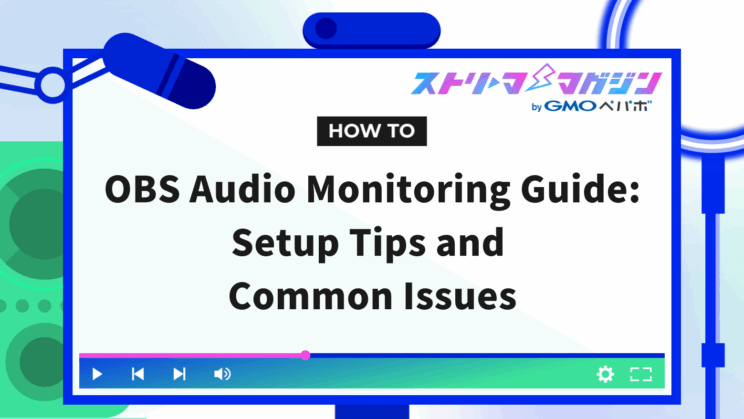OBS Audio Monitoring Guide: Setup Tips and Common Issues

Index
- What is OBS Audio Monitoring?
- How to Set Up Audio Monitoring in OBS
- Purposes of Using Audio Monitoring in OBS
- Common Troubles and Solutions with OBS Audio Monitoring
- Causes and Solutions if You Can’t Set Audio Monitoring in OBS
Are you struggling with comments from viewers during your game stream, such as “The mic is too quiet” or “The game sound is too loud”?
The bottom line is, by utilizing OBS’s audio monitoring feature, you can solve volume and sound quality issues, thereby enhancing viewer satisfaction.
This article provides a detailed explanation of how to set up and make use of OBS’s audio monitoring, as well as how to troubleshoot issues. By the end of this article, you’ll have concrete steps to prevent audio troubles and create a smooth streaming environment.
Be sure to read to the end.
What is OBS Audio Monitoring?
OBS audio monitoring is a crucial feature that lets you check audio in real-time during a stream or recording. It allows you to quickly check volume balance and noise levels to provide an optimal audio environment for your viewers.
For example, you can adjust the balance between game sound and mic audio while swiftly detecting unwanted noise. This can enhance the audio quality of your stream or recording and prevent trouble before it starts.
If you want to create an effective OBS streaming screen, check out the following article.
OBS Studio Streaming Setup Guide for Beginners: Easy Steps
How to Set Up Audio Monitoring in OBS
Here’s how to set up audio monitoring in OBS.
- Step 1: Check the Monitoring Device
- Step 2: Access Detailed Audio Properties
- Step 3: Adjust Audio Monitoring Settings
Let’s explain each step in detail.
Step 1: Check the Monitoring Device
To effectively use audio monitoring, it is crucial to set up the device you’ll be using correctly. Follow the steps below to proceed with the setup.
Procedure 1: Open the Settings Screen
First, open OBS and click “Settings.”
Procedure 2: Select the Audio Tab
Next, select “Audio.”
Procedure 3: Check the Monitoring Device Settings
Set the “Monitoring Device” in “Advanced Settings” to “Default.” This allows you to use the audio device registered by default on your computer.
If you need to use specific headphones or speakers, change the “Default” setting to the device you’ll be using.
Procedure 4: Save Settings
Finally, click the “OK” button to save the changes.
Step 2: Access Detailed Audio Properties
In detailed audio properties, you can finely manage each audio source’s monitoring and output settings.
Here’s how to do it.
Method 1: Access the Edit Menu
From the top of the screen, click “Edit” then “Advanced Audio Properties.”
Method 2: Access through the Audio Mixer
You can also open it from the gear icon on the “Audio Mixer.”
Step 3: Adjust the Audio Monitoring Settings
OBS allows the streamer to finely control how they check audio.
You can choose from the following three settings for audio monitoring.
- Monitor Off
- Monitor Only (Mute Output)
- Monitor and Output
Let’s explain the characteristics of each setting.
If you want to learn more about separating audio in OBS, check out the article below.
How to Separate Audio in OBS: Clear Guide for Different Streaming Styles
Monitor Off
“Monitor Off” is effective when you want to prevent echo or feedback caused by hearing audio from the speakers.
Additionally, in a fixed streaming environment where mic or audio settings don’t frequently change, it can reduce the load on the PC. “Monitor Off” is set by default, and this mode will be applied unless special settings are made.
Monitor Only (Mute Output)
“Monitor Only” allows the streamer to check audio in real-time in their environment, but the audio isn’t outputted to the stream or recording. It’s ideal for situations where the streamer doesn’t want the viewers to hear certain audio.
This is useful, for example, when checking specific sound effects or background sounds during a stream.
Moreover, you can balance and adjust delays while ensuring unnecessary sounds don’t mix into the stream, providing cleaner audio delivery.
Monitor and Output
With “Monitor and Output,” you can check audio in real-time, and that audio is included in the stream or recording. It is helpful when you want to check the audio yourself while delivering the same sound to the viewers.
It’s used, for instance, when you want to listen to music or game sound yourself and include that audio in the stream or recording as is.
Purposes of Using Audio Monitoring in OBS
The main purposes of using audio monitoring in OBS are as follows.
- Audio Check During Game Streaming
- Checking Mic Quality
- Checking Video Audio
Let’s take a closer look at each.
Audio Check During Game Streaming
When utilizing OBS in game streaming, you can capture game sounds into OBS using a capture card.
When you want to adjust the audio balance during streaming, change the audio monitoring settings in OBS appropriately.
By setting to “Monitor Only (Mute Output),” you can test audio quality yourself without affecting the stream. By choosing “Monitor and Output,” you can check audio while streaming.
Checking Mic Quality
Audio monitoring is also handy when you want to make detailed adjustments by checking the mic quality before streaming.
Using OBS’s mic test feature, you can check if the voice volume is too low or too high to cause distortion before the actual stream.
Moreover, by checking for noise or echo, you can ensure a clear audio stream.
Audio monitoring is a useful means of maintaining consistent quality, even during multi-person streaming or in environments with lots of ambient noise.
Checking Video Audio
When using saved videos in a stream via OBS, audio is initially set so that you cannot hear it yourself.
Therefore, it is crucial to adjust the audio monitoring settings properly if audio confirmation is necessary when playing a video.
If you want to check if the audio broadcasted in the stream doesn’t disturb the video’s audio balance, it is recommended to set to “Monitor Only (Mute Output).” You can check the audio yourself without affecting the stream.
On the other hand, setting to “Monitor and Output” allows you to monitor the audio played in the stream in real-time while making slight adjustments.
Common Troubles and Solutions with OBS Audio Monitoring
Let’s discuss common issues with OBS audio monitoring.
- No Sound is Heard
- Echo Occurs
- Audio Lag Occurs
- Sound Delay Exists
Let’s go through them along with solutions.
No Sound is Heard
If you can’t hear sound despite setting audio monitoring in OBS, there might be an issue with your settings or device connections. Sound not being heard often stems from the audio settings in OBS or issues with headphone/speaker connections.
As a solution, first, open OBS’s “Settings” and head to the “Audio” tab. Ensure the monitoring device’s settings are appropriate.
If the correct device isn’t set, you may not hear sound through audio monitoring in OBS.
Moreover, check your PC’s audio settings and ensure your headphones/speakers are properly connected and not muted.
If your microphone isn’t working in OBS and you’re unsure why, this article breaks down the possible causes and how to fix them:
Mic Not Working in OBS? Here’s How to Troubleshoot and Fix It
Echo Occurs
Echo is primarily caused when a mic picks up sound emitted from speakers. Solutions include distancing speakers and the mic or using a headset effectively.
Having multiple audio sources can also cause echoes, so remove them if unnecessary.
Errors in settings can cause issues like echo, so ensure proper adjustments for a comfortable streaming environment.
Audio Lag Occurs
Audio delays often result from excessive load on the PC or setup errors. Multiple applications running alongside OBS can lead to high PC load and subsequent audio lag.
Close unnecessary applications to reduce load, potentially resolving the issue.
Also, audio lag can occur when OBS settings do not match the sample rate of the mic or audio interface being used. Ensure the sample rates between OBS and the device are set to the same value.
For further insight into primary causes of audio lag, refer to the article below:
Fix OBS Audio Sync Issues: Causes and How to Adjust Settings
Sound Delay Exists
If there’s a delay in sound with OBS, understand that slight latency is inherent in the monitoring function.
One of the causes can be an outdated sound card driver, so updating to the latest version can help. Furthermore, limitations in PC specs can also be a factor, requiring you to close unnecessary apps and alleviate system load.
Add to that, improper OBS settings might also be contributing. Consider changing the sampling rate in the “Audio” tab from “48kHz” to “44.1kHz” for potential resolution.
Causes and Solutions if You Can’t Set Audio Monitoring in OBS
Lastly, the reasons you might be unable to set audio monitoring in OBS could be the following three.
- Improper PC Sound Settings
- Incorrect OBS Settings
- Connection Issues
Let’s go through each with solutions in mind.
Improper PC Sound Settings
If the PC’s sound settings aren’t correct, OBS may not recognize the output device, causing audio monitoring to malfunction.
First, open the sound settings and confirm if the output device is correctly selected. Also, ensure the device isn’t muted, and the volume is set properly.
Disabling and then re-enabling the device can also sometimes resolve the issue. Additionally, ensure the audio device is using the latest driver and, if updates are available, install the latest driver from the manufacturer’s official site.
Incorrect OBS Settings
A primary cause of nonfunctional audio monitoring in OBS can be misconfiguration within OBS itself. For example, the audio monitoring could be disabled, or an incorrect device might be set as the output destination.
If the setting is “Monitor Off”, the monitoring feature won’t work. Also, check in the “Settings” menu, under the “Audio” tab, that the output destination device is correctly set.
Connection Issues
Connection issues with audio devices can also be a reason OBS audio monitoring doesn’t function. If the device isn’t properly connected, OBS may not recognize the audio, causing monitoring malfunction.
Firstly, check that your headphones or mic are securely connected to the PC. If there are any cable looseness or damage, try a new cable or different port to reconnect.
For Bluetooth devices, verify if the pairing is complete and the connection is stable.
This time, we explained how to utilize OBS’s audio monitoring function to check the volume and sound quality of your stream in real-time. With the appropriate settings, you can deliver clear audio to your audience.








